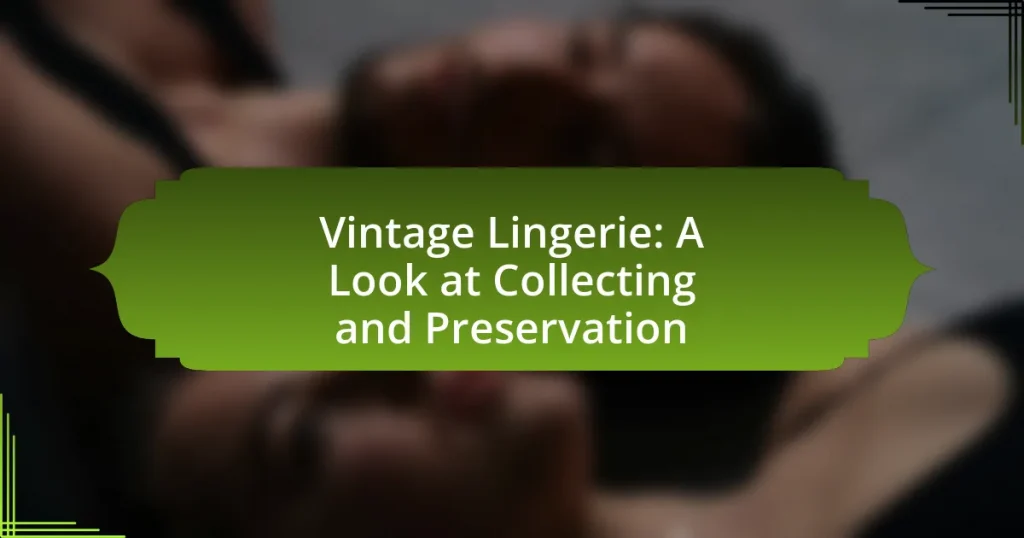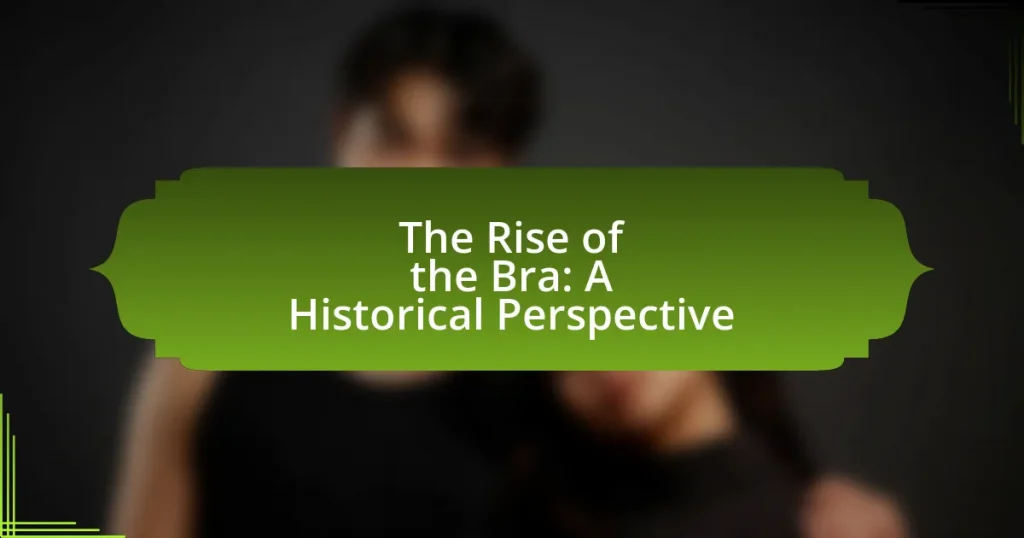The article “The Evolution of Corsets: Shaping Women’s Fashion Through the Ages” examines the historical significance and transformation of corsets in women’s fashion from the 16th century to the present. It details the origins of corsets, their structural evolution, and the societal expectations tied to their use, particularly during the Victorian era. The article also explores the decline of corsets in the early 20th century due to changing cultural attitudes and the rise of the feminist movement, as well as contemporary interpretations that emphasize body positivity and comfort. Additionally, it addresses the health implications of corset wear and provides guidance on selecting and wearing corsets effectively.
What is the history of corsets in women’s fashion?
The history of corsets in women’s fashion dates back to the 16th century when they were first introduced as a means to shape the female silhouette. Initially, corsets were made from materials like linen and whalebone, designed to create an hourglass figure that was highly desirable during the Renaissance. By the 19th century, corsets became more structured and were often tightly laced, reflecting societal ideals of femininity and modesty. The Victorian era saw the peak of corset popularity, with women wearing them daily, often leading to health issues due to restrictive designs. The early 20th century marked a decline in corset use as the feminist movement advocated for more comfortable and practical clothing, leading to the introduction of the brassiere. This shift in fashion reflected changing attitudes towards women’s roles in society and their bodies.
How did corsets originate and evolve over time?
Corsets originated in the late Middle Ages, primarily as a means to shape the torso and support the bust. Initially, they were made from stiffened fabric and worn under clothing to create a desired silhouette, reflecting the fashion ideals of the time. By the 16th century, corsets evolved into more structured garments, often featuring boning made from materials like whalebone or steel, which provided greater support and a more defined waistline.
Throughout the 17th and 18th centuries, corsets became increasingly popular among women of various social classes, with designs becoming more elaborate and decorative. The Victorian era marked a significant evolution, as corsets were tightly laced to achieve an exaggerated hourglass figure, which was considered the epitome of femininity.
In the early 20th century, the introduction of new materials and changing fashion trends led to a decline in the use of traditional corsets. The rise of the brassiere and more relaxed silhouettes in the 1920s further transformed women’s undergarments. By the mid-20th century, corsets were largely relegated to the realm of shapewear, with modern designs focusing on comfort and functionality rather than strict body shaping.
This historical progression illustrates how corsets have adapted to cultural shifts in fashion, body image, and women’s roles in society over time.
What were the earliest forms of corsets and their purposes?
The earliest forms of corsets, known as bodices or stays, emerged in the late 16th century and were primarily designed to shape the torso and support the bust. These garments were made from materials like linen or wool and often reinforced with whalebone or metal to achieve a desired silhouette. The purpose of these early corsets was not only to create an hourglass figure but also to provide support for the upper body, which was essential for the fashion of the time that emphasized a narrow waist and elevated bust. Historical records indicate that these garments were integral to women’s fashion, reflecting societal ideals of beauty and femininity during the Renaissance and Baroque periods.
How did cultural influences shape the design of corsets?
Cultural influences significantly shaped the design of corsets by reflecting societal norms, values, and aesthetics of different eras. For instance, during the Victorian era, the corset was designed to create an hourglass figure, symbolizing femininity and social status, which was influenced by the prevailing ideals of modesty and propriety. Additionally, the Industrial Revolution introduced new materials and manufacturing techniques, allowing for more intricate designs and wider availability, which further impacted corset styles. In contrast, the 1920s flapper movement led to a shift towards looser silhouettes, as women sought to break free from restrictive garments, showcasing how cultural shifts directly influenced corset design.
What role did corsets play in different historical periods?
Corsets served as a significant element in women’s fashion across various historical periods, primarily shaping body silhouette and societal norms. In the 16th to 18th centuries, corsets were used to create an idealized hourglass figure, reflecting the era’s beauty standards and social status. During the Victorian era, corsets became more structured, emphasizing a narrow waist and promoting modesty, which aligned with the period’s values of femininity and propriety. In the early 20th century, the introduction of the “flapper” style led to a decline in corset usage as women sought more freedom in movement and expression, marking a shift towards more practical and less restrictive clothing. By the mid-20th century, corsets evolved into girdles and shapewear, reflecting changing attitudes towards body image and comfort. Each period’s use of corsets illustrates the interplay between fashion, cultural values, and women’s roles in society.
How did the Victorian era redefine corset usage?
The Victorian era redefined corset usage by emphasizing an exaggerated hourglass figure, which became a symbol of femininity and social status. During this period, corsets were constructed with more rigid materials, such as whalebone and steel, allowing for tighter lacing and a more pronounced waistline. This shift was influenced by the prevailing ideals of beauty and modesty, as well as the rise of the middle class, who sought to emulate aristocratic fashion. The introduction of the “wasp waist” silhouette became prominent in the 1860s and 1870s, reflecting societal expectations of women’s appearance. Additionally, the Victorian era saw the popularization of corsetry as a commercial product, with specialized corset makers catering to the demand for fashionable and functional designs.
What changes occurred in corset styles during the 20th century?
During the 20th century, corset styles underwent significant transformations, shifting from restrictive designs to more comfortable and functional garments. Early in the century, corsets were characterized by their hourglass shape, emphasizing a narrow waist and were often made from stiff materials like whalebone and steel. However, by the 1920s, the introduction of the flapper style led to a decline in corset usage, as women favored looser silhouettes that allowed for greater freedom of movement.
The mid-century saw the rise of the “bullet bra” and girdles, which provided support without the extreme constriction of earlier corsets. By the 1960s and 1970s, the feminist movement further influenced corset styles, promoting body positivity and comfort, leading to the popularity of shapewear that offered light support rather than rigid structure. This evolution reflects broader societal changes regarding women’s fashion and body image throughout the century.
How have corsets influenced women’s body image and fashion trends?
Corsets have significantly influenced women’s body image and fashion trends by promoting an idealized hourglass figure and shaping societal perceptions of femininity. Historically, corsets were designed to cinch the waist and elevate the bust, creating a silhouette that was deemed attractive during various periods, particularly in the 19th century. This emphasis on a specific body shape led to a cultural standard that often pressured women to conform to these ideals, impacting their self-esteem and body image. For instance, the Victorian era saw women wearing corsets tightly laced, which not only altered their physical appearance but also reinforced the notion that beauty was synonymous with discomfort and restriction. The rise of the feminist movement in the 20th century challenged these norms, leading to a decline in corset usage and a shift towards more natural body representations in fashion. This evolution reflects broader societal changes regarding women’s autonomy and body positivity, illustrating how corsets have historically shaped both fashion trends and women’s perceptions of their bodies.
What societal expectations were tied to corset-wearing?
Corset-wearing was tied to societal expectations of femininity, modesty, and social status. During the 19th century, women were expected to conform to an idealized body shape that emphasized a small waist, which was often achieved through tight lacing of corsets. This practice reflected broader cultural values that associated physical appearance with virtue and respectability. Additionally, corsets were seen as a symbol of wealth and social class, as only affluent women could afford the elaborate garments and the necessary support to maintain them. Historical evidence shows that corsets were not merely fashion items but also tools of social conformity, reinforcing gender roles and expectations within society.
How did corsets contribute to the idealization of women’s bodies?
Corsets contributed to the idealization of women’s bodies by creating an exaggerated hourglass figure that emphasized a small waist and fuller hips and bust. This fashion trend, particularly prominent from the 16th to the early 20th centuries, reinforced societal standards of beauty that equated femininity with a specific body shape. Historical evidence shows that women often wore corsets tightly laced, sometimes to the point of discomfort, to achieve this desired silhouette, which was celebrated in art and literature of the time. The corset became a symbol of femininity and social status, further entrenching the idealization of women’s bodies within cultural norms.
What movements challenged the use of corsets in fashion?
The movements that challenged the use of corsets in fashion include the women’s suffrage movement and the health reform movement. The women’s suffrage movement, which gained momentum in the late 19th and early 20th centuries, advocated for women’s rights and autonomy, leading to a rejection of restrictive garments like corsets that symbolized oppression. Additionally, the health reform movement emphasized the importance of physical well-being, promoting natural body shapes and criticizing corsets for causing health issues such as respiratory problems and organ displacement. These movements collectively contributed to a significant decline in corset usage, particularly during the early 20th century, as women sought more comfortable and liberating clothing options.
How have modern interpretations of corsets changed fashion?
Modern interpretations of corsets have significantly transformed fashion by recontextualizing them as versatile garments that emphasize body positivity and personal expression rather than strict body shaping. Designers like Alexander McQueen and Jean Paul Gaultier have incorporated corsets into contemporary collections, showcasing them as statement pieces that challenge traditional notions of femininity and beauty. This shift reflects a broader cultural movement towards inclusivity and self-acceptance, as corsets are now often styled in ways that celebrate diverse body types rather than conforming to historical ideals. The rise of corset-inspired tops and dresses in mainstream fashion illustrates this change, with many brands offering designs that prioritize comfort and style over constriction, thus redefining the corset’s role in modern wardrobes.
What are contemporary designers doing with corset styles?
Contemporary designers are reinterpreting corset styles by integrating them into modern fashion, often emphasizing comfort and versatility. Many designers, such as Alexander McQueen and Jean Paul Gaultier, have incorporated corset elements into ready-to-wear collections, blending traditional structure with contemporary silhouettes. This evolution includes the use of innovative materials and techniques, allowing for greater flexibility and wearability, as seen in collections that feature corset-inspired tops paired with casual bottoms. Additionally, the rise of body positivity has led to a more inclusive approach, with designers creating corsets that cater to a diverse range of body types, thus challenging historical notions of beauty and fit.
How do corsets fit into today’s discussions on body positivity?
Corsets are increasingly viewed as symbols of body autonomy and personal expression in today’s discussions on body positivity. This shift reflects a broader understanding that body positivity encompasses the right to choose how one presents their body, whether through traditional means like corsets or other forms of self-expression. Historical context shows that corsets were once associated with restrictive beauty standards, but contemporary perspectives emphasize individual choice and empowerment, allowing people to embrace or reject corsetry based on personal preference. This evolution aligns with the body positivity movement’s goal of celebrating diverse body types and encouraging self-acceptance, demonstrating that the conversation around corsets has transformed from one of oppression to one of empowerment and self-definition.

What are the different types of corsets and their functions?
There are several types of corsets, each serving distinct functions. The most common types include the underbust corset, which supports the torso while allowing for freedom of movement and is often worn over clothing; the overbust corset, which provides support and shaping for the bust and is typically worn as a standalone garment; the waist cincher, designed to create an hourglass figure by compressing the waist; and the corset dress, which combines the structure of a corset with a dress for a cohesive look. Each type of corset has evolved to meet specific fashion needs, such as enhancing body shape, providing support, or serving as a fashion statement.
What are the main types of corsets available today?
The main types of corsets available today include underbust corsets, overbust corsets, waist cinchers, and corset tops. Underbust corsets sit below the bust and are often worn with a separate bra, providing support to the waist and hips. Overbust corsets cover the bust and provide full support, shaping the torso from the bust down to the waist. Waist cinchers are shorter and focus primarily on the waist area, often used for shaping without the full coverage of a traditional corset. Corset tops combine the elements of a corset with a blouse or top, offering a fashionable look while still providing some level of support and shaping. These categories reflect the diverse styles and purposes of corsets in contemporary fashion.
How do underbust and overbust corsets differ in design and use?
Underbust and overbust corsets differ primarily in their coverage and support. Underbust corsets extend from below the bust to the hips, providing support to the waist and shaping the lower torso, while overbust corsets cover the bust and extend down to the hips, offering support for both the bust and waist. The design of underbust corsets allows for more versatility in pairing with various tops, making them suitable for layering, whereas overbust corsets are often worn as standalone garments, emphasizing the bust and creating a defined silhouette. Historically, overbust corsets were more common in the Victorian era for achieving an hourglass figure, while underbust styles gained popularity in the 20th century for their practicality and comfort.
What is the purpose of waist training corsets?
The purpose of waist training corsets is to shape and reduce the waistline, creating an hourglass figure. Historically, these corsets were designed to provide support to the torso while emphasizing a narrow waist, which was considered a standard of beauty in various cultures. Evidence from fashion history indicates that waist training corsets were widely used from the 16th century onwards, with some women reportedly achieving waist reductions of several inches through consistent use. This practice was often linked to societal expectations of femininity and beauty, reinforcing the corset’s role in shaping women’s fashion throughout the ages.
How do corsets impact comfort and health?
Corsets significantly impact comfort and health by restricting movement and compressing internal organs. This restriction can lead to discomfort, difficulty breathing, and digestive issues, as evidenced by historical accounts where women reported fainting or experiencing rib pain due to tight lacing. Additionally, prolonged use of corsets has been linked to musculoskeletal problems, including postural issues and weakened core muscles, as the body becomes reliant on the corset for support rather than engaging its own musculature. Studies have shown that wearing corsets can alter the natural shape of the ribcage and pelvis over time, further complicating health outcomes.
What are the potential health risks associated with corset use?
The potential health risks associated with corset use include respiratory issues, digestive problems, and musculoskeletal pain. Corsets can restrict lung capacity, leading to difficulty in breathing, particularly when worn tightly. Additionally, prolonged use can compress the stomach and intestines, resulting in gastrointestinal discomfort and issues such as acid reflux. Furthermore, corsets can alter posture and place undue stress on the spine, contributing to back pain and muscle strain. Studies have shown that women who wore corsets frequently reported these health complications, highlighting the risks involved in their use.
How can one choose a corset that balances style and comfort?
To choose a corset that balances style and comfort, one should prioritize fit and material. A well-fitted corset should contour to the body without excessive tightness, allowing for ease of movement. Materials like cotton or silk provide breathability and comfort, while structured designs can enhance style without sacrificing wearability. Research indicates that corsets made with flexible boning and adjustable lacing offer both aesthetic appeal and comfort, as they accommodate various body shapes and sizes.
What tips should one consider when wearing a corset?
When wearing a corset, one should ensure proper fit and comfort to avoid health issues. A well-fitted corset should allow for breathing and movement without excessive restriction, as tight lacing can lead to complications such as rib damage or organ displacement. It is advisable to gradually increase wear time to allow the body to adjust, as sudden tight lacing can cause discomfort. Additionally, wearing a corset over a layer of clothing can prevent skin irritation and enhance comfort. Historical evidence shows that improper corset use led to various health problems in women, emphasizing the importance of mindful wearing practices.


